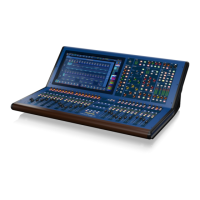168 HD96-24-CC-TP User Manual
Item Control Function
11 Power Button Bypasses the eect.
12 Global Knee Control Compression knee adjustment from 4 dB (Soft) to 40 dB (Hard).
13 Low Mid Control Adjust the low/mid crossover point frequency. 40 Hz to 1 kHz.
14 Mid High Control Adjust the mid/high crossover point frequency. 640 Hz to 16 kHz.
Klark Teknik SQ1 Compressor/Gate
A veritable toolbox of dynamics processing, SQ1D provides either compression or gating with side chain ltering and monitoring. SQ1D features multiple compression
modes with combinations of RMS and Peak sensing and Hard and Soft Knee characteristics, ideal for both corrective and creative dynamics processing. In conjunction
with the fully-featured noise gate and side chain options.
SQ1 features a “Vintage” switch allowing the selection of the default RMS sensing compression mode, or when engaged, an emulation of many older compressor
designs with exponential attack and release envelopes. When used in conjunction with the “Hard Knee” switch, SQ1D provides several dierent forms of compression
to suit a wide range of programme material. By default, SQ1D oers a Soft Knee response, however when the “Hard Knee” switch is activated, a Hard Knee response is
provided instead.
With both mode switches inactive the compressor behaves in the default RMS and Soft Knee modes. This gives the slowest (and most subtle) feel to the compressor
envelopes. The soft knee curve combines with the adaptive RMS attack and release times to produce gentle envelope responses that are ideal for compressing
vocals, but which can still be aggressive enough to limit transients when needed. The Soft Knee curve also reduces the adaptive nature of the RMS detection slightly,
providing a little more manual control of the envelope timings.
When the Hard Knee response is used with RMS mode, the compressor operates in a more clinical way with a more dened transition between under threshold and
over threshold - this is better suited to limiting style compression. A small amount of the soft knee curve is still retained keeping the sound reasonably natural but
with no modication of the compressor envelope. This means that attacks are more aggressive, but it also allows the adaptive nature of the RMS detection to operate
to its fullest extent. This mode is good for natural sounding limiting of speech.
With the “Vintage” switch active and the default Soft Knee response selected, the compressor employs a dual time constant, linear attack prole. This produces
extremely subtle attack and release curves during the onset of compression that are largely independent of the envelope control settings. As the compressor is driven
harder (i.e. signal’s further over threshold) the soft knee eect reduces, gradually returning manual control of the attack and release times to optimise capture of
larger transients. Like the RMS modes, this compressor mode is very adaptive making set up of the envelope controls relatively easy. The peak sensing, however,
increases harmonic overtones, which adds a “Vintage” brightness and sparkle to the audio, producing extremely transparent and lively sounding compression of
acoustic instruments.
When both the “Vintage” and “Hard Knee” switches are selected, the compressor operates with more precise envelope control and a dened transition between
under- and over-threshold. This produces aggressive compression that gives fast control of extremely dynamic material. It can also be used to add colour to low
frequency signal’s making it ideal for controlling instruments such as bass guitar. With the highest ratio setting, this mode allows the compressor to eectively be
used as a limiter.
The Gate has the iTs feature which operates in conjunction with the Gate Hold control to reduce false triggering of noise gates. When signal’s (especially low frequency
ones) are very close to the gate threshold, a gate can repeatedly open and close on the audio. iTS ensures that the gate remains open by automatically adjusting the
gate threshold downwards the moment the signal goes over the threshold setting. When the signal eventually falls below the (new) temporarily adjusted threshold,
the iTS function resets, ready for the next gate opening. This hysteresis action results in more decisive operation of the noise gates, and attack envelopes also start
instantly and consistently, even on signal’s that are only slightly over threshold.

